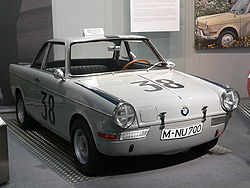BMW 700
 | |
| Manufacturer | BMW |
|---|---|
| Also called | BMW LS |
| Production | 1959–1965 188,211 built Saloon: 154,557 Coupé: 31,062 Convertible: 2,592 |
| Predecessor | BMW 600 |
| Successor | BMW MINI |
| Layout | RR layout |
| Engine(s) | 697 cc Flat-2 |
| Transmission(s) | 4 speed manual |
| Wheelbase | 2120 mm (83.5 in) LS: 2280 mm (89.8 in) |
| Length | 3540 mm (139.4 in) LS: 3860 mm (152 in) |
| Width | 1480 mm (58.3 in) |
| Height | 1270 mm (50 in)−1360 mm (53.5 in) |
| Curb weight | 640 kg (1411 lb)−690 kg (1521 lb) |
The BMW 700 is a small rear-engined car produced by BMW from August 1959 to September 1965, based on the BMW 600 (which was based on the Isetta). Unlike the 600, however, the 700 was an all steel monocoque structure. Styling was by Giovanni Michelotti – the car is sometimes compared with his other popular design of the same period, the Triumph Herald. A coupé and a cabriolet were also produced, whose bodies were made by Karosserie Baur of Stuttgart.
It was powered by a 2-cylinder, air-cooled engine of 697 cc from the BMW R67 motorcycle. The base version engine produced 32 PS (23.5 kW/31.6 bhp). A top speed of 125 km/h (78 mph) was claimed.
In March 1962 the 700 saloon models were replaced by the BMW LS saloon, essentially the same car, but with its wheelbase stretched by 160 mm (6.3 in) and 320 mm (12.6 in) longer. In September 1964 the Coupé received, for its last year, the longer chassis and body and was accordingly rechristened BMW LS Coupé.
The 700 is one of several models credited with having rescued BMW from a terrible fate. By the time production ended, 188,211 had been produced which was more than five times the number achieved by its predecessor model. This level of hitherto unprecedented commercial success enabled the company's small share holders, supported by a major share holder named Herbert Quandt, to block a threatened take-over by Mercedes-Benz. The business thus stabilised, in 1961, BMW would be able to launch a second Michelotti styled sedan. The BMW 1500, supported by the sudden removal from the market place of the Borgward Isabella, put an end to acute financial pressures that had haunted the business for two decades.
The 700 RS was a highly tuned version for racing. It had special, lightweight, aerodynamic bodywork and an engine tuned to 70 PS (69 hp/51 kW). Hans Stuck campaigned the car with success. Jacky Ickx also raced in 700s.
After production ended, BMW did not enter production of very small cars again until 2001 with the Mini.





![Validate my RSS feed [Valid RSS]](valid-rss-rogers.png)















































































ไม่มีความคิดเห็น:
แสดงความคิดเห็น